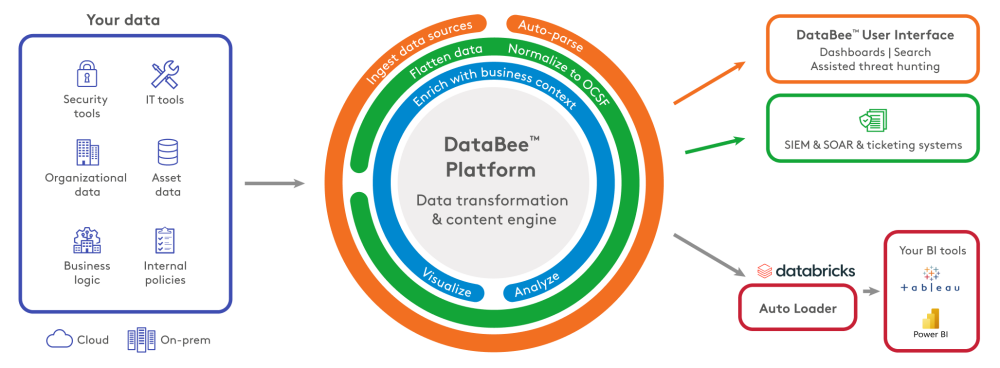In today's fast-paced and data-driven world, businesses are constantly seeking ways to gain a competitive edge. One of the most valuable assets these businesses have is their data. By analyzing and deriving insights from their data, organizations can make informed decisions, manage organizational compliance, optimize resource allocation, and improve operational efficiency.
Better together: DataBee and Databricks
As part of DataBee® v2.0, we’re excited to announce a strategic partnership with Databricks that gives customers the flexibility to integrate with their data lake of choice.
DataBee is a security, risk, and compliance data fabric platform that transforms raw data into analysis-ready datasets, streamlining data analysis workflows, ensuring data quality and integrity, and fast-tracking organizations’ data lake development. In the medallion architecture, businesses and agencies organize their data in an incremental and progressive flow that allows them to achieve multiple advanced outcomes with their data. From the bronze layer, where raw data lands as is, to the silver layer, where data is minimally cleansed for some analytics, to the gold layer, where advanced analytics and models can be run on data for outcomes across the organization, let DataBee and Databricks get your data to gold.
In the past, creating gold-level datasets was a challenging and time-consuming process. Extracting valuable insights from raw data required extensive manual effort and expertise in data aggregation, transformation, and validation. Organizations had to invest significant resources in developing custom data processing pipelines and dealing with the complexities of handling large volumes of data. Lastly, legacy systems and traditional data processing tools struggled to keep up with the demands of big data analytics, resulting in slow and inefficient data preparation workflows. This hindered organizations' ability to derive timely insights from their data and make informed decisions.
DataBee's integration with Databricks empowers customers to take their gold-level datasets up a notch by leveraging advanced data transformation capabilities and sophisticated machine learning algorithms within Databricks. Regardless of whether the data is structured, semistructured, or unstructured, Databricks' unique lakehouse architecture provides organizations with a robust and scalable infrastructure to store and manage vast amounts of data and insights in SQL and non-SQL formats. The lakehouse architecture from Databricks allows businesses to leverage the flexibility of a data lake and the analysis efficiency of a data warehouse in a unified platform.
The integration between DataBee and Databricks involves two key components: the Databricks Unity Catalog and the Auto Loader job.
The Databricks Unity Catalog is a unified governance solution for data and AI assets within Databricks that serves as a centralized location for managing data and its access.
The Auto Loader automates the process of loading data from Unity Catalog-governed sources to the Delta Lake tables within Databricks. The Auto Loader job monitors the data source for new or updated data and copies it to the appropriate Delta Lake tables. This ensures that the data is always up to date and readily available for analysis within Databricks. When integrating DataBee with Databricks, the data is loaded from the Databricks Unity Catalog data source using the Auto Loader, ensuring that it is easily accessible and can be leveraged for analysis.
This seamless integration, combined with DataBee's support for major cloud platforms like AWS, Google Cloud, and Microsoft Azure, enables organizations to easily deploy and operate Databricks and DataBee in their preferred cloud environment, ensuring efficient data processing and analysis workflows.
Connecting security, risk, and compliance insights faster with DataBee
It’s time to start leveraging your security, risk, and compliance data with DataBee and Databricks.
DataBee joins large security and IT datasets and feeds close to the source, correlating with organizational data such as asset and user details and internal policies before normalizing it to the Open Cybersecurity Schema Framework (OCSF). The resulting integrated, time-series dataset is sent to the Databricks Data Intelligence Platform where it can be retained and accessible for an extended period. Empower your organization with DataBee and Databricks and stay ahead of the curve in the era of data-driven decision-making.


